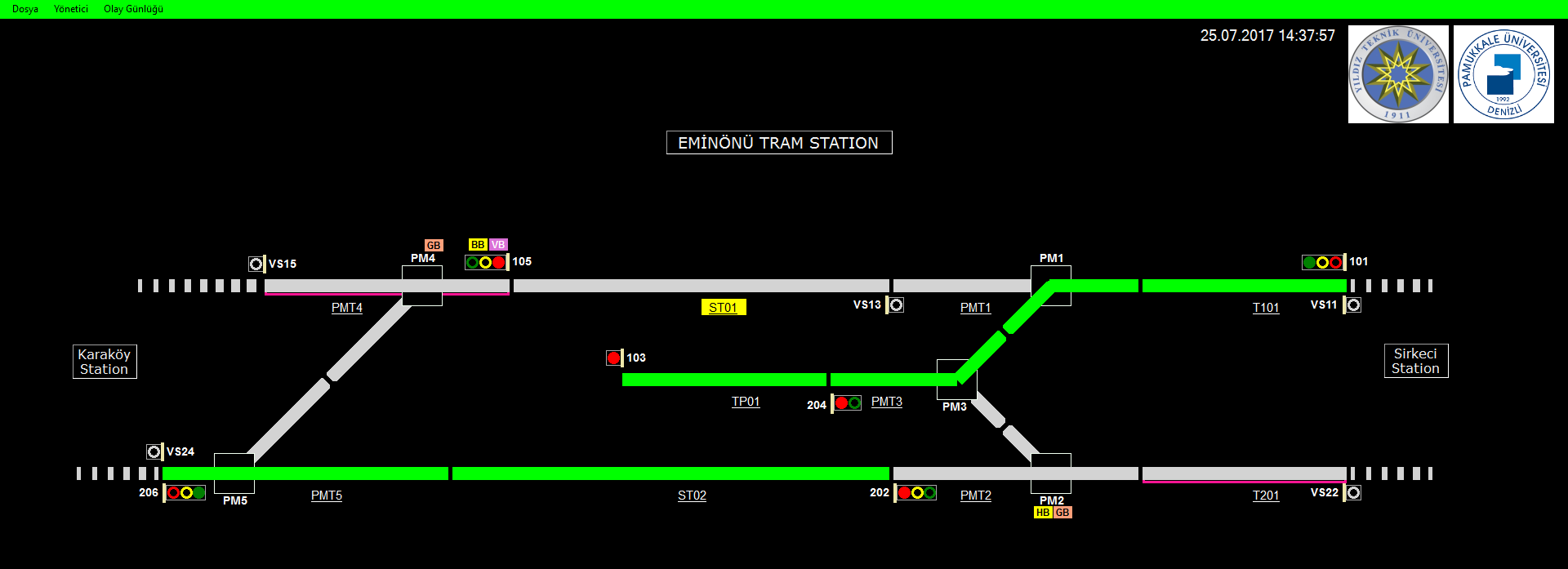PAU RAILWAY RESEARCH GROUP
Project Name: Fail-Safe PLC implementation of Interlocking System Design with Fault Diagnosis capability for Fixed-block Railway Signaling Systems (TUBITAK - 115E394)

Project Summary:
The use of railway transportation among different alternatives (e.g. road and air transportation) brings many profits such as less carbon dioxide emission and energy consumption. Railway signaling systems are mainly divided into two main groups such as fixed-block and moving-block. Independent of the signaling category, the vital component of railway systems which provides safe travel and transportation is the interlocking system (IS). Train operations in fixed-block signaling systems are realized by route reservation procedures. Railway lines are divided into fixed-length blocks (tracks) where each railway block has an entrance and an exit signal. These signals inform the train drivers about the occupation of the next railway block. Each railway block is permitted to be occupied by only one train at a time.

Fixed-block signaling systems are consists of three main parts: The traffic command center (TCC), IS and the field equipment. The IS works as an evaluation and decision-making mechanism between the TCC and the field equipment. Railway signaling systems are classified as safety-critical systems by the international safety standards due to the occurrence of faults may result with huge loss of life and property. Therefore, the design of the IS for fixed-block signaling systems is realized by considering the national and international safety standards.
The path to be followed in the design of the IS for the fixed-block signaling systems is defined by the V-model given in the IEC 61508-3 and the EN 50128 standards. At first, the requirements of the IS are determined in the V-model and the software is realized at the desired Safety Integrity Level (SIL) by using the recommended methods and architectures which are also defined in the safety standards. However, the design errors arises at the test phase while developing the safety-critical software according to the V-model. After the errors are detected, the designer passes to the modeling phase again and all software development process is being initiated from the very beginning. When considering that the testing phase for a medium-scaled railway field takes 2-3 weeks, there arises a huge loss of time and workforce.
In this project, the proposed method allows the diagnosis of faults by using the obtained models in the software development process before passing to the test phase and permits the obtained models to be checked again. This project basically consists of four sections:
1. Determining the relations of possible routes and the field equipment for the chosen railway field (contruction of the interlocking table), determining the traffic command center requirements (software, hardware and testing), determining the interlocking system requirements (software, hardware and testing) and determining the software requirements of the field,
2. Modeling the field equipment by using Petri net method which is also recommended by the safety standards, construction of the fault diagnosers of the field equipment and showing that the system is fault diagnosable,
3. Implementation of the Petri net models and the fault diagnosers on fail-safe PLCs, implementation of the traffic command center SCADA software on PC and implementation of the field software on fail-safe PLC,
4. Verification of the developed software by the software tests.


Diagnosability analysis for fixed-block signaling systems can be considered as an intermediate step between modeling the system and testing the developed software. Even though the design of the diagnoser can be seen as a time-consuming and stringent task for signaling system software developers but it determines whether the developed system models are diagnosable or not before testing the signaling system software. Another benefit of this intermediate step is to combine the theoretical and the practical experience of signaling system engineers. In addition to the interlocking software, another software will be also realised for the TCC in this project. Additionally, another fail-safe PLC which is independent from the IS PLC will be provided to work as the real railway field. Thus, application of a real fixed-block railway system design can be realised.
